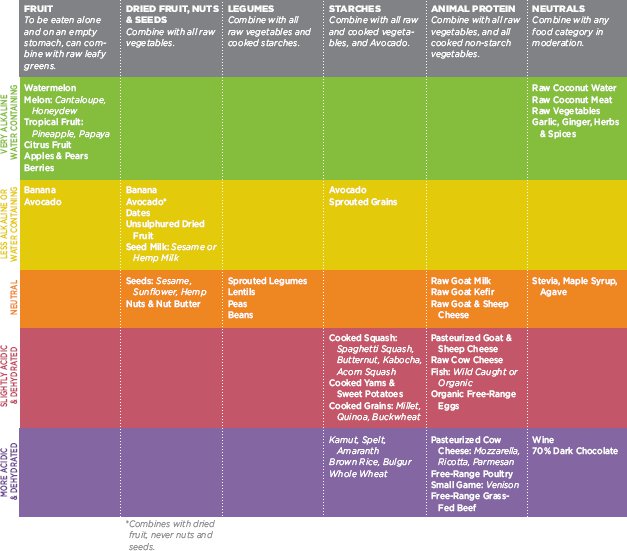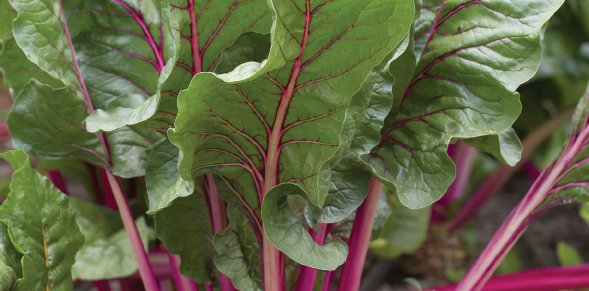
FOOD COMBINING
For optimal digestion, a meal or snack must move quickly through the stomach for assimilation and elimination. Different types of foods require different types of stomach enzymes to break them down, and some combinations of these will clash and dilute one another’s effectiveness. Therefore, eating meals in harmonious combinations ensures that stomach enzymes will have an easy time breaking down the meal for assimilation. This is an essential part of the detoxification process.
When you are mindful of proper food combining, your stomach thanks you for it by moving meals swiftly and painlessly through your digestive system, you draw greater energy from the foods you eat, and you shed excess waste and weight. When you regularly consume poor food combinations, your stomach becomes a battleground of enzymes working at cross-purposes, which obstructs proper digestion, produces gas and bloat, and creates hothouse conditions for yeasts, mold, and bacteria.
Take a look at the following food categories and our recommended foods in each, and use them as a guide to create easy-to-digest meals.
ANIMAL PROTEINS
Optimal foods within this category:
- Raw sheep and goat dairy
- Organic free-range eggs
- Wild or organic fish
- Free-range chicken and game (enjoy occasionally, if desired)
These can be safely consumed in the company of raw vegetables and any cooked, nonstarchy vegetables (see the next category for examples of starchy foods to avoid when eating in this category) or with other animal proteins.
COOKED STARCHY VEGETABLES AND GRAINS
Optimal foods within this category are:
- Yams
- Sweet potatoes
- Acorn squash
- Kabocha squash
- Butternut squash
- Millet, quinoa, buckwheat
These can be safely consumed in the company of any raw or cooked vegetables, as well as with avocados.
NUTS AND SEEDS
Optimal foods within this category are:
- Sesame seeds
- Raw sesame tahini
- Sunflower seeds
- Raw nuts to be used for nut milks (almond, macadamia, pecan, walnut)
These can be safely consumed in the company of any raw vegetables or other nuts, seeds, or dried fruits, as well as bananas. Avocados can be combined with dried fruit, but never nuts or seeds.
However, dried fruits and nuts—even the soaked and sprouted raw variety—should not be the focal point of the modern detox diet. Nuts are dense and grow fungus easily, and dried fruit has a sugar content that will feed systemic yeast growth.
FRUIT
The modern detox diet is low in sugar and only includes low-sugar fruit as desired. Thus, the optimal foods in this category are:
- Green apples
- Grapefruit
- Lemons and limes
- Berries
- Avocados
Fruit should be consumed alone, or with raw leafy greens such as spinach or lettuce, and always on an empty stomach. Once the system has been significantly cleansed and alkalinized, all fruits may be enjoyed alone and on an empty stomach.
NOTE: Avocados are technically a fruit, but they can be enjoyed with all vegetables, cooked or raw, and with all starches. They also go very well with dried fruits and bananas. The only things avocados don’t combine with are flesh and dairy—so leave avocados out of those goat cheese salads.
LEGUMES
Legumes are mostly starchy but have enough protein in them to make them a food-combining challenge. This is why most people find that legumes give them gas. Legumes do not qualify as easy-to-combine quick-exit fare, which is why they are not a focus of the modern detox diet. However, the smaller the legume, the easier it is to digest. Lentils and split peas, for example, can be enjoyed with any raw or cooked vegetables, as well as with avocados.
TOP ITEMS FOR YOUR DETOX GROCERY LIST
Nature spreads a cornucopia of vegetables, fruits, and herbs before us, but there are some among them that are particularly important to the detox diet. These specific foods are not only nutritionally dense, with wonderful healing and anti-inflammatory properties, but they lend a great deal of gastronomic value to any dish. The combination of healing properties and culinary enrichment are what keep them at the top of our grocery list all year round.
AVOCADOS: Contrary to popular belief, the mighty avocado is not a harbinger of weight gain. When properly combined, it moves seamlessly through the digestive tract, offering the body its nutritional value and life force, and makes a quick exit. This is definitely a case where a food cannot be judged by its caloric and fat content alone.
BEETS: “Where have you been all my life?” That’s the question you will ask when you discover baked beets. In addition to the gorgeous color, when baked, beets take on a rich, “meaty” texture that is deeply satisfying and slightly sweet. They also have the most positive effect on digestion. I have a rather unorthodox way of preparing beets that Doris teases me about, but I’ll share it with you: I wash them, leaving the skins on, then simply place them whole and unwrapped on a baking sheet and bake them in the oven at a very low temperature (approximately 275°F) for 4 to 5 hours. The long duration and low temperature protect their delicate skins from becoming burnt and brittle. Instead, the skins bake soft and chewy and become very much a part of the delicacy. These slow-cooked beets are a sweet, hearty comfort food. Eat them fresh from the oven (you’ll find the warmth and consistency provide the satisfaction of a much heavier starch), or chill them overnight and add them to salads for a robust, caramelized flavor and texture the next day. Beets are a light quick-exit food (even when cooked, they are still very moist and water-containing). Beets combine beautifully with fleshes and starches alike, making them extremely versatile. They are a mainstay for me in the fall and winter months.
FOOD COMBINING AND ALKALINITY INDEX

LEMONS: Since lemons are juicier than limes, we typically reach for lemons over limes for our recipes, unless the specific lime flavor is required. Although lemons are technically a fruit, and good food combining requires keeping fruits away from other foods, lemons are different. There is no fruit sugar in lemons, so they can combine with absolutely anything. Lemons are one of many raw fruits that are unfairly blamed for causing acidity. When organically grown and picked ripe, lemons—like tomatoes, oranges, and other natural foods that are acidic outside the body—actually have an alkaline effect in the body because they are life force rich and alkaline in nature. By contrast, there are many foods that are considered nonacidic outside the body (such as milk) that actually have an acidic effect in the body. We love the fresh taste of lemon in green juice, salad dressings, and herbal teas.
GINGER: This well-known anti-inflammatory root is often used by naturo-paths to reduce arthritis and ease other joint problems. It has so many uses in natural medicine—such as easing colic, motion sickness, and digestion—but we use it mainly because we just love the flavor. We love the way it combines with lemon in green juice and how it mixes with garlic to breathe authenticity into ethnic dishes and robust flavor to soups.
GARLIC: Garlic is a potent antibacterial agent and fungicide also widely used in natural medicine to cure all sorts of infections, from asthma to parasites. While it’s always nice to know that freshly diced garlic is keeping unfavorable microbes at bay, again, we mainly just love the way garlic elevates the flavor of our salads, soups, and cooked vegetable and fish dishes.
GOAT AND SHEEP CHEESE: I am the first one to admit that if it were not for goat and sheep cheeses, I probably would not have been able to detox over the long term. But add the cheese, and I’m good for life. Of course, goat and sheep cheeses (particularly in their raw, unpasteurized form) are special. They are easy to digest—unlike their pasteurized cow cheese counterparts, which, on a molecular level, have a more complex casein component. After you’ve had one of our goat cheese salads, you will understand how we could easily walk away from cow milk products and be perfectly happy in detox-land. Goat and sheep dairy combine best with all raw vegetables, all cooked nonstarchy vegetables, eggs, and fish. Viva il formaggio!
BROCCOLI AND CAULIFLOWER: These cruciferous vegetables appear frequently throughout this book because of their heartiness and versatility. Many of the recipes are innovative, converting cauliflower and broccoli into “rice” or as a base for flatbreads or pizza crusts, a great alternative to grains. Some people find it very difficult to digest these cruciferous vegetables raw, and consuming too much of them may produce gas and bloating. This is easily remedied by breaking down the cellulose by blanching, steaming, or roasting the vegetables before consuming.
SPINACH: Classic steamed spinach is a detox staple. It is light and easy to digest, and adds wonderful warmth and density to a meal. Don’t underestimate what steamed spinach can bring to a dish. For a detox-friendly alternative to traditional creamed spinach, try melting goat cheese on a plate of piping-hot spinach and dig in.
